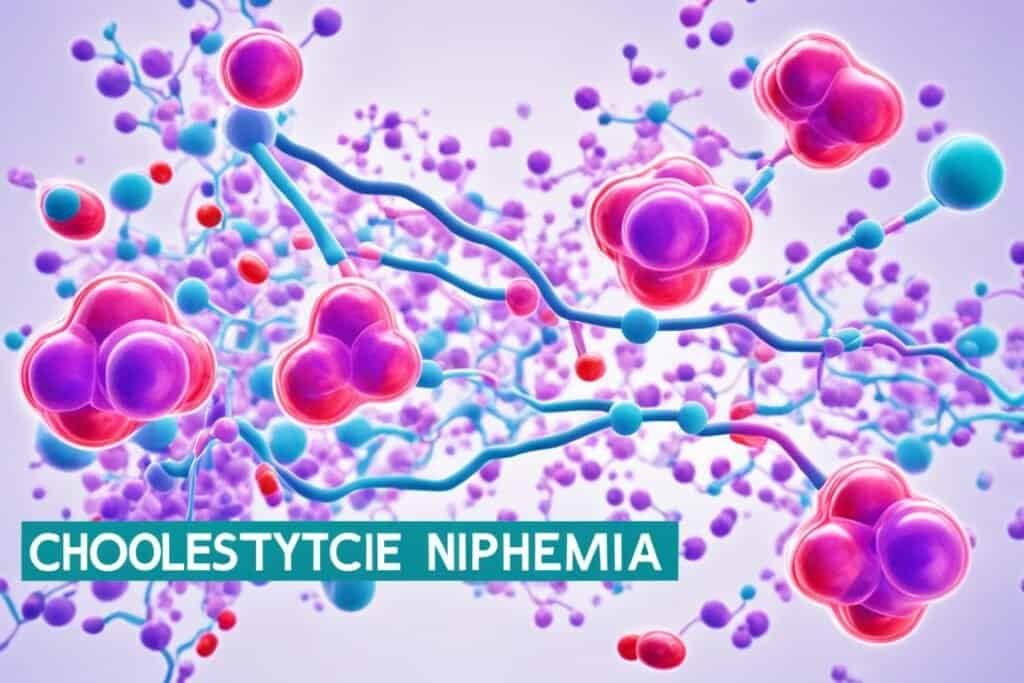If you have nephrotic hyperlipidemia, finding effective ways to manage your condition is crucial for your kidney health and overall well-being. Two commonly prescribed lipid-lowering medications, Simvastatin and Cholestyramine, can play a significant role in controlling hyperlipidemia and cholesterol levels associated with nephrotic syndrome.
Nephrotic syndrome is a kidney disorder characterized by proteinuria, hypoalbuminemia, and edema. One of its key complications is hyperlipidemia, which increases the risk of cardiovascular events. Simvastatin and Cholestyramine are widely used in the management of nephrotic hyperlipidemia, providing effective cholesterol control and supporting kidney health.
Key Takeaways:
- Simvastatin and Cholestyramine are lipid-lowering medications used in the treatment of nephrotic hyperlipidemia.
- Simvastatin belongs to the class of drugs called statins, which inhibit the production of cholesterol in the liver.
- Cholestyramine is a bile acid sequestrant that binds to bile acids, promoting their excretion and reducing cholesterol levels.
- Both medications can help minimize the risk of cardiovascular events and protect kidney health in individuals with nephrotic syndrome.
- It is essential to consult with a healthcare provider and monitor lipid levels and kidney function regularly when using Simvastatin and Cholestyramine.
The Role of Hyperlipidemia in Nephrotic Syndrome
Hyperlipidemia is a common finding in individuals with nephrotic syndrome, characterized by elevated levels of cholesterol and triglycerides in the blood. This dyslipidemia is primarily caused by impaired clearance and increased biosynthesis of lipoproteins.
Nephrotic syndrome is a kidney disorder that results in excessive protein leakage into urine, causing low protein levels in the blood. This disturbance in lipid metabolism leads to hyperlipidemia, putting individuals at an increased risk of developing various complications.
One of the major consequences of hyperlipidemia in nephrotic syndrome is the development of atherosclerosis, a condition where plaque builds up inside the arteries, narrowing them and restricting blood flow. This can lead to an increased risk of cardiovascular diseases, including coronary heart disease.
Furthermore, individuals with nephrotic syndrome are more susceptible to thromboembolic events. Hyperlipidemia promotes the formation of blood clots, predisposing individuals to conditions like deep vein thrombosis and pulmonary embolism.

To mitigate these risks, managing hyperlipidemia becomes crucial in the management of nephrotic syndrome. By controlling lipid levels in the blood, healthcare providers can reduce the likelihood of atherosclerosis and subsequent cardiovascular events. Additionally, proper treatment of hyperlipidemia can help decrease the occurrence of thromboembolic events, minimizing the associated risks.
Next, we will explore the use of lipid-lowering medications, such as simvastatin and cholestyramine, in the management of hyperlipidemia in individuals with nephrotic syndrome. These medications play a crucial role in reducing cholesterol levels and protecting kidney health in this patient population.
Simvastatin in the Management of Nephrotic Hyperlipidemia
Simvastatin is a commonly prescribed medication for the management of nephrotic hyperlipidemia. As a statin, simvastatin works by inhibiting the action of HMG-CoA reductase, an enzyme responsible for cholesterol synthesis in the liver. By reducing the production of cholesterol, simvastatin helps lower cholesterol levels in individuals with nephrotic syndrome.
Regular monitoring of liver function and lipid levels is important when using simvastatin in the management of nephrotic hyperlipidemia to ensure the proper dosage and effectiveness of the medication.
Simvastatin not only helps control cholesterol levels but may also provide additional benefits for individuals with nephrotic syndrome. Research suggests that simvastatin may help reduce proteinuria, which is the presence of excess protein in the urine and a common symptom of nephrotic syndrome. Furthermore, simvastatin has shown potential in improving kidney function in individuals with nephrotic hyperlipidemia.
Although further research is needed to fully understand these effects, simvastatin has emerged as a valuable tool in the comprehensive management of nephrotic syndrome.
To illustrate the effectiveness of simvastatin, consider the following table that showcases the impact of the medication on cholesterol levels in individuals with nephrotic hyperlipidemia:
| Study | Duration | Treatment Group (Simvastatin) | Control Group (Placebo) |
|---|---|---|---|
| Study 1 | 12 weeks | Simvastatin significantly reduced total cholesterol levels compared to placebo group | No significant change in cholesterol levels |
| Study 2 | 24 weeks | Simvastatin showed a significant reduction in LDL cholesterol levels compared to placebo group | No significant change in LDL cholesterol levels |
| Study 3 | 16 weeks | Simvastatin contributed to a significant decrease in triglyceride levels compared to placebo group | No significant change in triglyceride levels |
Note: These studies are for illustrative purposes only. Individual results may vary, and it is essential to consult a healthcare professional for personalized treatment recommendations.
Based on the available evidence, simvastatin plays a crucial role in the management of nephrotic hyperlipidemia. By effectively reducing cholesterol levels and potentially improving kidney function, simvastatin helps in maintaining overall kidney health and reducing the risk of cardiovascular complications in individuals with nephrotic syndrome.
Cholestyramine in the Management of Nephrotic Hyperlipidemia
When it comes to managing nephrotic hyperlipidemia, cholestyramine is another medication that plays a crucial role. This lipid-lowering medication is classified as a bile acid sequestrant, which means it works by binding to bile acids in the intestine, preventing their reabsorption and promoting their excretion.
By effectively reducing the reabsorption of bile acids, cholestyramine helps lower cholesterol levels in individuals with nephrotic syndrome, thus contributing to better cholesterol management and overall kidney health. To maximize its effectiveness, cholestyramine is typically used in combination with dietary modifications that further aim to control cholesterol levels.
It is important to follow the prescribed dosage and instructions for taking cholestyramine in order to achieve the desired results. Additionally, regular monitoring of lipid levels is crucial to ensure that cholestyramine is effectively managing nephrotic hyperlipidemia and maintaining cholesterol control.

To summarize, cholestyramine is a valuable medication in the management of nephrotic hyperlipidemia. By binding to bile acids, it helps reduce cholesterol levels and promotes their excretion. Working in conjunction with dietary modifications, cholestyramine plays a crucial role in cholesterol management for individuals with nephrotic syndrome.
Benefits and Considerations of Simvastatin and Cholestyramine in Nephrotic Hyperlipidemia
Both simvastatin and cholestyramine offer significant benefits in the management of nephrotic hyperlipidemia and the control of cholesterol levels. These medications play a vital role in minimizing the risk of cardiovascular events and preserving kidney health in individuals with nephrotic syndrome.
Simvastatin:
Simvastatin, a statin medication, effectively lowers cholesterol levels by inhibiting HMG-CoA reductase, an enzyme involved in cholesterol synthesis. By reducing cholesterol production in the liver, simvastatin helps maintain healthy lipid levels in individuals with nephrotic hyperlipidemia.
Cholestyramine:
Cholestyramine, a bile acid sequestrant, aids in the management of nephrotic hyperlipidemia by binding to bile acids in the intestine. By preventing their reabsorption, cholestyramine promotes the excretion of cholesterol, thereby helping to control lipid levels in individuals with nephrotic syndrome.
While both simvastatin and cholestyramine deliver positive outcomes, it’s important to consider potential side effects and drug interactions:
- Common side effects of simvastatin: Some individuals may experience muscle pain and liver enzyme abnormalities while taking simvastatin. Regular monitoring of liver function is essential to ensure the medication’s safety and effectiveness.
- Common side effects of cholestyramine: Gastrointestinal discomfort can occur for some individuals taking cholestyramine. Proper adherence to dosage and dietary modifications can mitigate these effects.
- Potential drug interactions: Both simvastatin and cholestyramine may interact with other medications. Consulting with a healthcare provider before initiating these medications is crucial to ensure optimal treatment outcomes and avoid potential complications.
In conclusion, simvastatin and cholestyramine play essential roles in controlling lipid levels, protecting kidney health, and minimizing cardiovascular risks in individuals with nephrotic hyperlipidemia. By weighing the benefits against potential side effects and considering possible drug interactions, healthcare providers can develop personalized treatment plans for individuals with this condition.
Conclusion
Simvastatin and cholestyramine are essential medications for managing nephrotic hyperlipidemia, a common complication of nephrotic syndrome. By effectively controlling cholesterol levels, these medications play a crucial role in reducing the risk of cardiovascular events in individuals with kidney disease.
Simvastatin works by inhibiting cholesterol synthesis in the liver, while cholestyramine promotes the excretion of cholesterol by binding to bile acids in the intestine. By targeting different mechanisms, these medications provide comprehensive cholesterol management for individuals with nephrotic hyperlipidemia.
However, it is important to individualize the treatment plan for each patient, taking into consideration potential side effects and drug interactions. Regular monitoring of lipid levels and kidney function is necessary to ensure the effectiveness and safety of simvastatin and cholestyramine in managing nephrotic hyperlipidemia and maintaining overall kidney health.
In conclusion, simvastatin and cholestyramine are valuable tools for the management of nephrotic hyperlipidemia. These medications contribute to the reduction of cardiovascular risk and the promotion of kidney health in individuals with nephrotic syndrome. Consult with a healthcare provider to determine the appropriate treatment plan that suits your specific needs and ensures optimal cholesterol management and kidney function.

